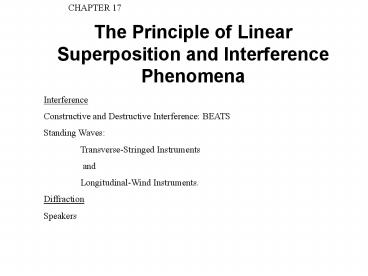The Principle of Linear Superposition and Interference Phenomena - PowerPoint PPT Presentation
Title:
The Principle of Linear Superposition and Interference Phenomena
Description:
http://www3.interscience.wiley.com:8100/legacy/college/cutnell/0471151831/c oncepts/index.htm ... A 10-Hz sound wave and a 12-Hz sound wave, when added together, ... – PowerPoint PPT presentation
Number of Views:47
Avg rating:3.0/5.0
Title: The Principle of Linear Superposition and Interference Phenomena
1
The Principle of Linear Superposition and
Interference Phenomena
CHAPTER 17
Interference Constructive and Destructive
Interference BEATS Standing Waves Transverse-St
ringed Instruments and Longitudinal-Wind
Instruments. Diffraction Speakers
2
Beats with tuning forks
3
Simulation of Beats
http//www3.interscience.wiley.com8100/legacy/col
lege/cutnell/0471151831/concepts/index.htm
4
Beat Wave Pattern
A 10-Hz sound wave and a 12-Hz sound wave, when
added together, produce a wave with a beat
frequency of 2 Hz. The drawings show the pressure
patterns (in blue) of the individual waves and
the pressure pattern (in red) that results when
the two overlap.
5
17.4 Beats
6
17.4 Beats
Musical instruments are tuned by listening to the
beat frequency. For instance, a piano tuner
listens to the beats produced between the string
and a source with the correct frequency. The
piano tuner adjusts the tension in the string
until the beats vanish, ensuring that the string
is vibrating at the correct frequency.
7
17.5 Transverse Standing Waves
8
17.5 Transverse Standing Waves
A standing wave is an interference effect that
can occur when two waves overlap.
9
17.5 Transverse Standing Waves
A standing wave is an interference effect that
can occur when two waves overlap. Standing
waves can arise with transverse waves, such as
those on a guitar string, and also with
longitudinal sound waves, such as those in a
flute.
10
17.5 Transverse Standing Waves
A standing wave is an interference effect that
can occur when two waves overlap. Standing
waves can arise with transverse waves, such as
those on a guitar string, and also with
longitudinal sound waves, such as those in a
flute. In any case, the principle of linear
superposition provides an explanation of the
effect, just as it does for diffraction and
beats.
11
Simulation of Standing waves
http//www3.interscience.wiley.com8100/legacy/col
lege/cutnell/0471151831/concepts/index.htm
12
Standing wave patterns
13
Problem-25
The G string on a guitar has a fundamental
frequency of 196 Hz and a length of 0.62 m. This
string is pressed against the proper fret to
produce the note C, whose fundamental frequency
is 262 Hz. What is the distance L between the
fret and the end of the string at the bridge of
the guitar (see Figure 17.20b)?































